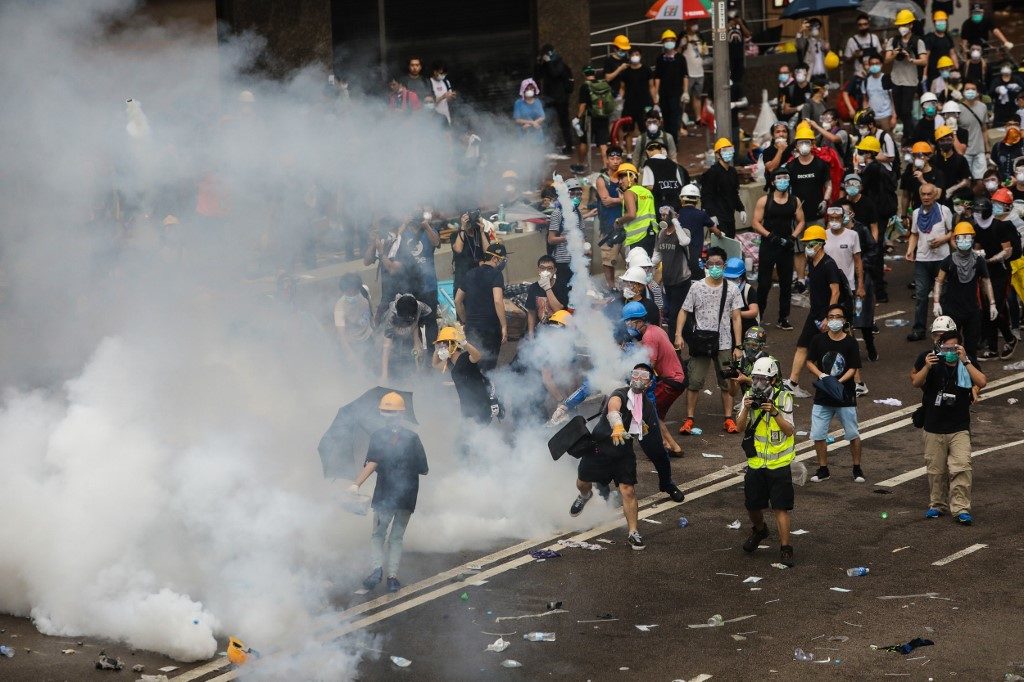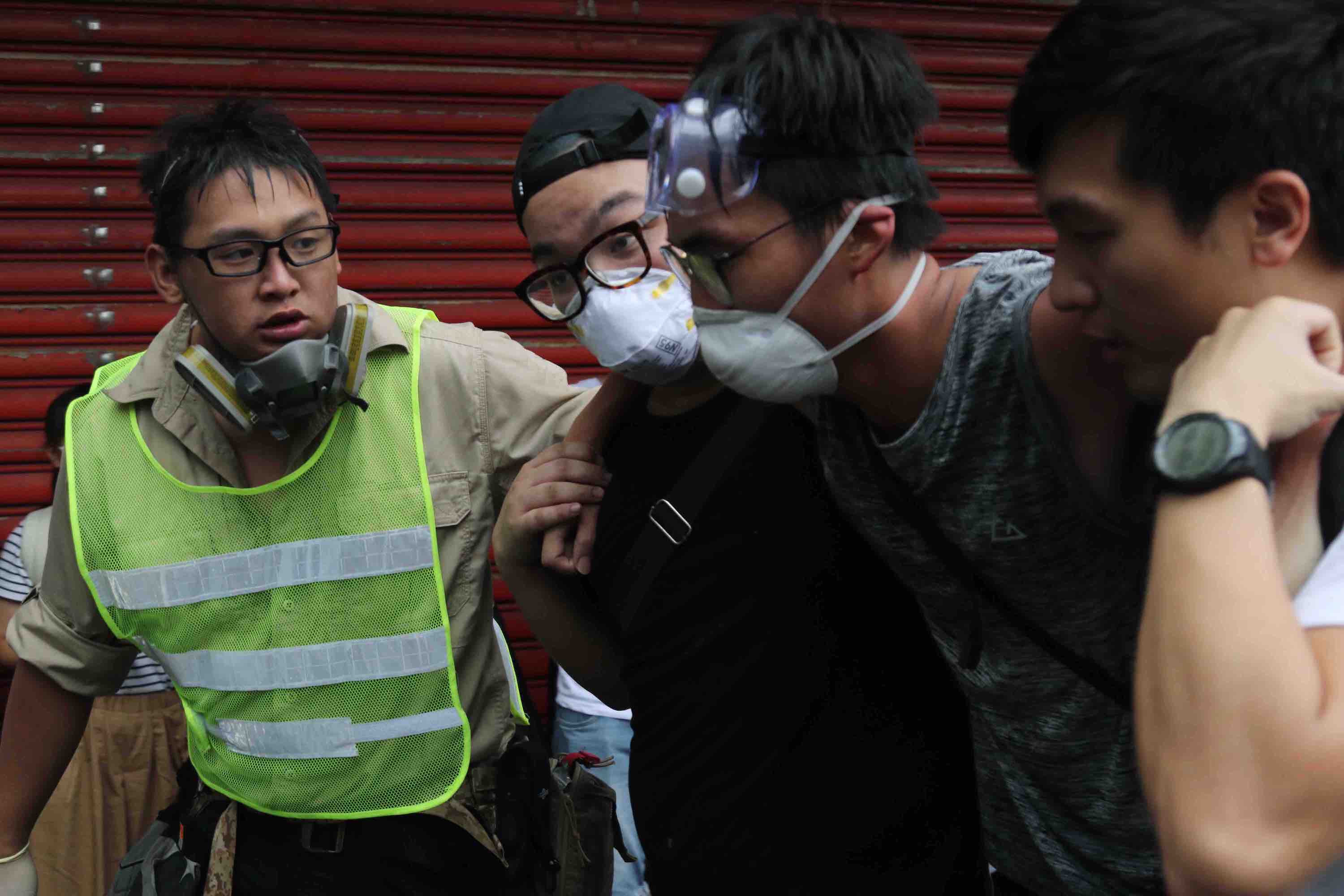Tens of thousands of Hongkongers stood up today to voice their opposition to a controversial bill that would allow extradition to mainland China, only to be beaten back by a barrage of tear gas canisters and rubber bullets as police moved to decisively crush their occupation of Admiralty.
Demonstrators filled Harcourt Road in front of the Legislative Council, where lawmakers were scheduled to hold the second reading of the extradition bill this morning, while another contingent milled around Tamar Park and the area behind the council, and still more thronged around the entrances of Tim Mei and Tim Wa avenues.
In a sign of the erosion of trust between demonstrators and the government, many showed up prepared for a heavy-handed police response, which was not the case at a record-breaking march protesting the bill on Sunday. Today, many protesters wore helmets and some carried solutions for washing pepper spray out of eyes. Almost all wore face masks — both to protect against tear gas, and as many protesters explicitly stated, to avoid being identified amid heightened fears of aggressive surveillance and prosecution.
Before noon, in a brief statement, the Council announced that it would be postponing the second reading of the bill, but far from dispersing, protesters began erecting more makeshift barricades, saying they had little faith that the government was truly backing down.
“[The barricades are] just to not let those people into the Council so they cannot start the process of the law, because we don’t have enough votes in the Council” to block it, said one man, who was lashing together barricades with zip ties on Queensway.
Outside LegCo, faith in the announced delay is not widespread. "[THE barricades] are to not let those people into the council so they cannot start the process of the bill, because we don’t have enough votes (to block it)," one protester told us. #HongKong #NoExtraditionToChina pic.twitter.com/ih4on8vahF
— Coconuts Hong Kong (@CoconutsHK) June 12, 2019
Asked how he would react to an aggressive police response, he said protesters wouldn’t provoke, but “need[ed] to do the maximum to protect themselves.”
Calls for today’s demonstration went out after Sunday’s enormous march failed to sway Chief Executive Carrie Lam, who on Monday acknowledged the protests, but would only say that the government’s “explanation” of the legislation would need to improve — “even after the enactment of the bill.”
Protesters’ suspicions that the bill was far from dead appeared to be confirmed by Chief Secretary Matthew Cheung, who in a video appeal early this afternoon called on demonstrators to clear the roads, and suggested that the government’s patience for “explanation” had reached an end.
He said that authorities had “intensively explained the original intent and content of the amendments in the past few months, and we have substantially strengthened human rights and other safeguards in response to the opinions of the parties.” Failure to pass the law, he continued, put Hong Kong at risk of becoming a “haven for fugitives.”
All of the protesters interviewed by Coconuts HK, however, said they wouldn’t settle for anything less than the complete withdrawal of the bill. As protester Alexandra Wong put it, “until that happens, we’ll keep coming out.”
Police first deployed tear gas shortly before 4pm today, after scores of officers in full riot gear streamed out of the government office complex and began establishing a perimeter around the building.
Scores of police in riot gear just came streaming out of the government office complex. pic.twitter.com/BBThmOp8rU
— Coconuts Hong Kong (@CoconutsHK) June 12, 2019
As the gas drifted into the crowd, protesters began falling back, tears streaming down their faces, many coughing and gagging on the acrid smoke.
“They’re shooting us to hurt us,” one 24-year-old media executive told Coconuts HK this afternoon, seemingly more wounded by the fact her own police force would employ tear gas against she and her fellow protesters than the fact she’d walked into clouds of it more than once.
With each successive volley of tear gas, protesters would flee the vicinity — at times banging on the doors and windows of nearby office buildings begging to be let in — only to regroup after a short distance, unwilling to abandon the occupied areas.

But it wasn’t only gas being fired by Hong Kong police.
Police Chief Stephen Lo admitted as much at a late-afternoon press conference, where he described the protest as a riot situation that demanded the use of force, including rubber bullets and bean bags fired from guns. Protesters, he said, had planned to use “metal bars” to stab the police on hand.
One man, a driver for the broadcaster RTHK, was shot in the head with a tear gas round, and sent unconscious to Queen Mary Hospital. It was later reported that his heart actually stopped at one point, but he was reportedly in stable condition as of press time.

Man-kei Tam, director of Amnesty International Hong Kong, condemned the response, accusing the police of taking “advantage of the violent acts of a small minority as a pretext to use excessive force against the vast majority of peaceful protesters.”
“Tear gas and projectiles, like rubber bullets, are notoriously inaccurate and indiscriminate, and can result in serious injury, and even death,” Tam said in a statement. “They should only ever be used in a targeted response to specific acts of violence, and never to disperse peaceful protesters.”
Videos from the scene also showed police, seemingly unprovoked, savagely beating an unarmed man with truncheons and hosing down demonstrators with streams of pepper spray.
https://twitter.com/SamuelLau16/status/1138744348688900096?s=20
Chief Executive Lam, however, in a tearful interview with local broadcaster TVB, said it was the protests that should be “strongly condemn[ed].”
“This is not an act out of love for Hong Kong,” she said.
“Since the handover, some people will use matters involving the central and Hong Kong governments, mainland and Hong Kong, to incite confrontation,” she went on to add. “Radical confrontation is not the solution.”
One protester, who asked to be identified only as Liu, said she had been singing hymns when police first fired the tear gas. Noting the intensity of the response, she added, “they don’t want the Umbrella Movement happening again.”
“Maybe this time it’s not an Umbrella Revolution, but they don’t want people to occupy Central or Admiralty,” she said, unsure of whether she would stick out the protest to the end. “So I think this time they’re putting more force on it, and then they’re using more tear gas.”
Bloomberg reported that at least 22 demonstrators were injured, according to the city’s Hospital Authority.
As the gas forced most protesters out of the Harcourt Road area, a large contingent began making its way down Queensway, bringing the demonstration into Central just as many office workers were heading home.
The crowd is heading deeper into Central, still thousands strong. #NoExtraditionToChina pic.twitter.com/qWiMv0VNlR
— Coconuts Hong Kong (@CoconutsHK) June 12, 2019
Some blocked intersections with commandeered traffic cones, while one gaggle of sympathetic motorists stopped their cars across several lanes of Connaught Road, bringing traffic to a standstill and honking along with protest chants as hundreds of onlookers cheered.
Stragglers were still staging splintered protests as of press time, but it remained unclear whether police would launch a renewed clean-up operation as the night wore on, or what tomorrow might bring.
One 20-something technician, who declined to be named, told Coconuts HK that he had no confidence that the government would reconsider the bill, saying the LegCo was “just stalling,” and would reschedule the second reading of the bill once people were “mentally tired” of protesting.
Even so, he said, he wouldn’t be returning tomorrow, having taken a sick day to be able to attend today’s demonstration.
“There will be people, but a lot less,” he predicted.
A 24-year-old student who also declined to give her name, however, vowed to return.
“It was too much for us, and we think it was unfair,” she said of the police response. “They just think we are youths doing some illegal thing… but as Hong Kong people, it’s our responsibility to voice what we think.”
“Once this ordinance is approved,” she added, “Hong Kong is game over.”
Reporting by Stuart White, Vicky Wong, and Iris To.
CORRECTION: An earlier version of this story incorrectly stated that an RTHK driver was shot with a rubber bullet. The outlet actually reports that it was a tear gas round. Coconuts HK apologizes for any confusion caused.


